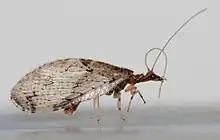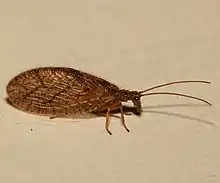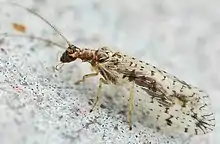Micromus
Micromus is a genus of lacewings in the family Hemerobiidae (the brown lacewings). These small (4–10 mm long) insects are found worldwide.[1] Like most lacewings, both the larvae and adults are predatory, primarily eating acarines, scale insects, psyllids, aphids, thrips, and the eggs of lepidopterans and whiteflies. The species Micromus tasmaniae has been mass-bred for biological pest control in Australia.[2]
| Micromus | |
|---|---|
 | |
| Micromus tasmaniae | |
| Scientific classification | |
| Domain: | Eukaryota |
| Kingdom: | Animalia |
| Phylum: | Arthropoda |
| Class: | Insecta |
| Order: | Neuroptera |
| Family: | Hemerobiidae |
| Genus: | Micromus Rambur, 1842 |
| Synonyms | |
| |
Species
There are more than 80 species in the genus, and possibly as many as 170.[3][4]
 Micromus africanus
Micromus africanus Micromus angulatus
Micromus angulatus Micromus bifasciatus
Micromus bifasciatus Micromus posticus
Micromus posticus Micromus variegatus
Micromus variegatus.jpg.webp) Campodeiform larva of Micromus posticus
Campodeiform larva of Micromus posticus
References
- The Global Biodiversity Information Facility: GBIF Backbone Taxonomy doi:10.15468/39omei Accessed via https://www.gbif.org/species/2097002 on 2016-09-12
- New, TR (2002). "Prospects for extending the use of Australian lacewings in biological control" (PDF). Acta Zoologica Academiae Scientiarum Hungaricae. 48 (Supplement 2): 209–216.
- "Micromus (Brown Lacewings) - Taxonomy". Retrieved 28 February 2018.
- "Browse Micromus". Catalogue of Life. Retrieved 2018-02-28.
External links
Wikimedia Commons has media related to Micromus.
Wikispecies has information related to Micromus.
This article is issued from Wikipedia. The text is licensed under Creative Commons - Attribution - Sharealike. Additional terms may apply for the media files.